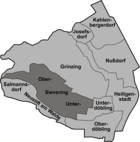Sievering
This article needs additional citations for verification. (January 2017) |
| Sievering | |
|---|---|
| Coat of arms | Map |
 |
 |
Sievering is a suburb of
For many years it was home to the
Geography
Sievering arose on the banks of the
History

The origin of the name Sievering
The first official mention of Sievering dates to 1114 and names it Sufringen. Over time, the name evolved into Suueringan, Sivring and finally into Sievering. The affix -ing in many Germanic place names has the meaning the place of the people belonging to; Sievering thus means the place of the people belonging to a man named Suver(o)/Sufr. A link was probably made to
Sievering from the Roman Empire to the end of the Middle Ages
At the time of the
Sievering since the Middle Ages

Sievering and the surrounding settlements suffered greatly during the Ottoman wars in Europe, which greatly impeded their development. In 1634, Obersievering and Untersievering once again received new rulers; Obersievering went to the Camaldolese from Kahlenberg, while Untersievering went to the Gaming Monastery. When the plague hit Vienna in 1713, Sievering suffered particularly badly. 30 of the 33 houses in Obersievering were afflicted, in Untersievering the numbers were 32 of 34. 267 people in all died of the plague in Sievering. In the following decades, Obersievering developed much less rapidly than Untersievering as a result of its cooler, moister climate and poor transport links. In 1767, Obersievering had 41 houses and 26 farmhouses, while Untersievering had just 5 farmhouses. By 1819, Untersievering had overtaken the settlement further upstream - in its 56 houses, Untersievering had 467 inhabitants, while in Obersievering, 377 people were living in 52 houses. From 1789 onwards, private individuals built canals and ponds, planted fruit trees, bred sheep, set up a park and built a farmhouse. In 1832, wood merchant Josef Müller was finally able to reunite both settlements under one owner. He later sold them to Anton Edler von Wirth, who had also purchased Oberdöbling in 1824.
When they were integrated into the city of Vienna in 1892 together with
Economy
At the start of the 19th century, both parts of Sievering had large vineyards. In the somewhat smaller Untersievering, half of the available land was given over to growing wine. Agriculture took up another third. In Obersievering, 28% of available land were covered with vineyards, followed by 20% forest, 15% pasture and 15% fields. The quarry, which had been in use since Roman times, and which belonged to the City of Vienna, was economically important. It provided cobblestones and whetstones until it closed in 1921. Unlike nearby Grinzing or Neustift am Walde, Sievering was not considered an attractive summer destination and grapes grew more slowly in the cool valley than on the surrounding hilltops. The roads connecting Sievering with the surrounding areas were also very poor well into the 19th century. Nonetheless, factories were gradually established here as well and in 1837 a wagon line connected Sievering with Vienna for the first time. In 1875, the expansion of Untersievering began, while the gradual fencing in of the Arbesbach provided protection from floods.
In 1897, carpenter Wenzl Hartl founded a noteworthy steam-driven sawmill at number 2 in the Sieveringer Straße. The sawmill grew quickly as the construction industry became more professional, but was moved to Lower Austria in 1948. Terraced houses and the Franz Josef Hotel took its place. It was however the automobile factory Gräf & Stift that held the title as the largest enterprise in Sievering. Its factory in the Weinberggasse, which was opened in 1904, produced cars, trucks, and busses. The site was replaced with residential housing after production was moved step-by-step to Liesing.
References
- Franz Mazanec: Grinzing und Sievering: die Dörfer unter'm Himmel. [Sutton], Erfurt 2006, ISBN 3-86680-007-X
- Godehard Schwarz: Döbling. Zehn kulturhistorische Spaziergänge durch Wiens 19. Bezirk. Wien 2004
